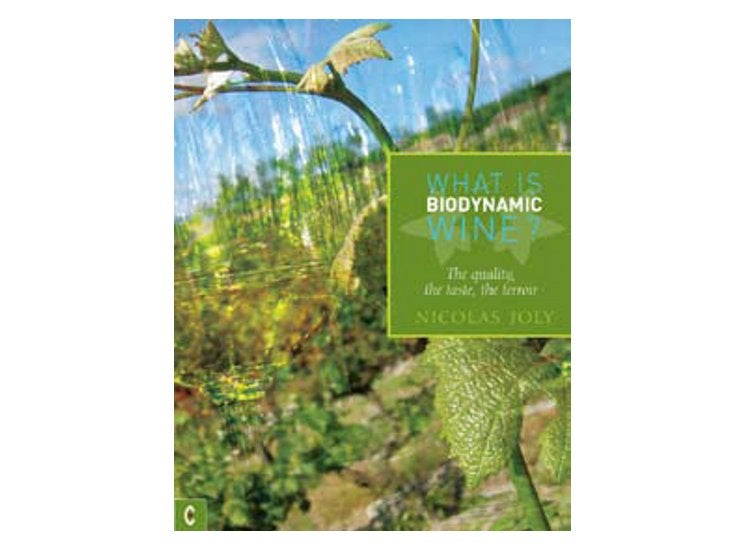
Nicolas Joly
What Is Biodynamic Wine: The Quality, the Taste, the Terroir (translated from French by Matthew Barton)
Published by Clairview Books UK £9.99, US $19.69
Reviewed by Monty Waldin
At the beginning of this book Nicolas Joly describes himself as a passionate defender of the French concept of appellation d’origine contrôlée (AOC). He contends that “only an agriculture that takes full account of the laws of nature and its underlying forces […] can help generate the authentic diversity of expression implicit in each AOC”.
No one can fault Joly’s passion, but the way he vilifies the agrochemical industry and blames it rather than wine producers for abandoning the weed plow in favor of weedkiller is inaccurate and prone to a double-standard. Joly says agrochemical companies have “orchestrated” their market and “trapped” wine producers, despite them having had a free market choice between plow and weedkillers. Yet Joly then lauds the free-market concept when it means wine drinkers are using their purchasing power to buy biodynamically grown wines. It is also anachronistic to assert that the first weedkiller salesmen (in the 1950s) hid from wine growers the effect that their products would have on the mychorrizal fungi that allow vine roots to express the AOC or terroir concept.
When the first weedkillers appeared, soil biology was little understood. This tendency to let emotion cloud the facts is a constant theme. Joly deals only in absolutes: Teachers in agricultural schools are “intellectually arid,” “torturers,” and “kow-towing” to agri-business (p.84). Joly cites not a single piece of scientific research to back up his arguments either for biodynamics or against agrochemicals.
We hear only of “certain scientists”, “a big international funding programme”, “a promising project”, but never which one. His descriptions of important biodynamic concepts such as the four states of matter and lunar cycles are clumsy and better described in English by authors such as Andrew Lorand,
Alan York, or Hugh Courtenay, or in French by François Bouchet. The fact that it takes Joly until halfway through the book to deal with the nuts and bolts of biodynamics is surprising (p.59). And for a book with such a title, it is inexcusably negligent with regard to how biodynamics works in a wine context. One of the nine so-called preparations that biodynamic growers must use in order to be considered as such — the fresh tea or fermented liquid manure made from the horsetail herb — is completely overlooked. Biodynamicists believe that this preparation pushes fungal diseases off the vines and back to the soil level where they belong. It is crass to rail against the “commercially wily” chemical industry for producing anti-fungal sprays without once mentioning this ready biodynamic alternative.
On several occasions Joly says he has “no time” to go into details — which might be understandable enough in a time-limited public lecture but surely not for a book of this type. And in fact, he could have dealt with the question posed by his book’s title — “What is biodynamic wine?” – by answering, “A wine made from grapes farmed using the nine biodynamic preparations.”
Joly deals with winemaking in Chapter 3 before turning to viticulture in Chapter 4, which aptly illustrates this book’s overriding confusion. Other examples abound. Joly’s description of an all-in-one spray containing six (or seven — we don’t know) of the biodynamic preparations is utterly confusing because the difference between what he calls “dung” and what he calls “manure” is unclear. We don’t know whether the spray is Alex Podolinsky’s prepared horn manure (made from biodynamic horn manure, or horn dung, as Joly insists on calling it, and the six biodynamic compost preparations) or Maria Thun’s barrel compost spray (made from fresh manure and the six biodynamic compost preparations).
Because Joly’s writing style is so opaque it blurs our understanding of why the “forces” that biodynamicists recognize are so important (p.87) – for our crops and, thus, for our food and for our spirits. Saying “biodynamics responds at the energy level to an alarming [that is, manmade] imbalance” is exactly the kind of gobbledegook that gives biodynamics the reputation for “sorcery” that Joly is so lamentably trying to correct.
The final irony is that the “Charter of Quality”, which is supposed to “permit an appellation to express itself fully” is a “system of evaluation [that] does not speak of ‘biodynamic’ or ‘non-biodynamic.'” This runs counter to the apparent thrust of the book – namely that the appellation concept works better when biodynamic methods are employed. Joly claims that all the members of his Return to Terroir association are third-party certified organic or biodynamic.
From personal experience, I know of wine growers in this group who have no certification, who do not use biodynamic preparations, and who are content to use the kind of products that Joly says run counter to the appellation concept. These producers appear to use the Return to Terroir association as a means of jumping on the biodynamic bandwagon. It is tempting to believe that Joly’s book is doing the same.






